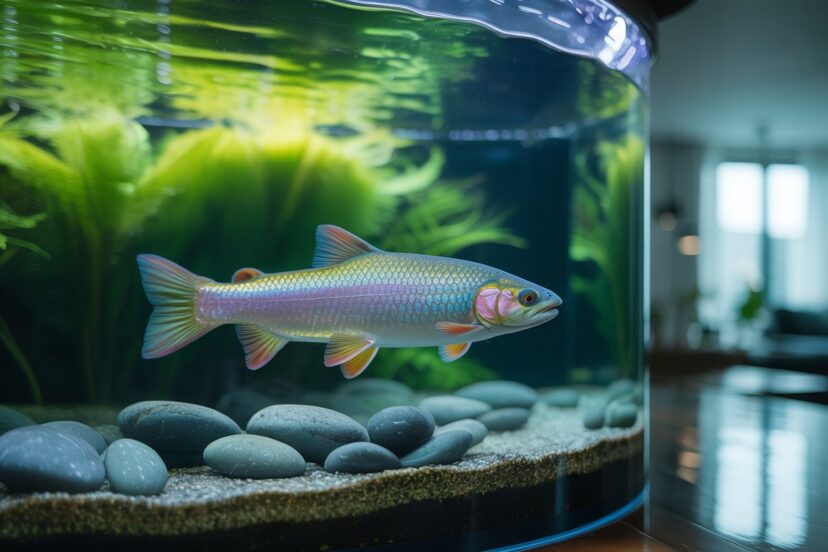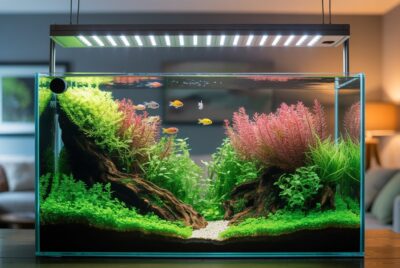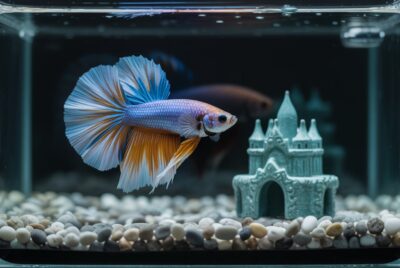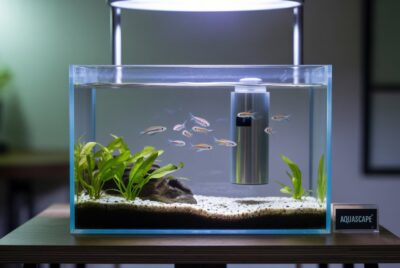Coldwater Fish: Complete Guide for Beginners and Enthusiasts
*We may earn a commission for purchases made using our links. Please see our disclosure to learn more.
My journey into the world of coldwater fish began on a chilly autumn afternoon when I stood in front of a pet store display, mesmerized by the graceful movements of goldfish in their crystal-clear tank. Their vibrant colors and peaceful swimming patterns sparked something inside me – a connection I couldn’t quite explain at the time. Little did I know that this moment would be the beginning of a fascinating adventure that would transform not only my living space but also my understanding of aquatic life and even my daily routine.
For many people, the term “aquarium fish” immediately conjures images of exotic tropical species requiring heated tanks and specialized care. However, coldwater fish offer a wonderful alternative that’s often overlooked. These remarkable creatures thrive in unheated tanks, are generally more resilient, and bring a unique charm to any home aquatic setup.
Whether you’re a complete beginner intimidated by the complexity of tropical setups or an experienced hobbyist looking to explore new waters, coldwater fish present an accessible yet rewarding path into the aquarium hobby. Through my own trials, errors, and eventual successes, I’ve discovered that creating a thriving coldwater aquarium environment isn’t just about keeping fish alive – it’s about creating a living ecosystem that brings joy, tranquility, and a touch of natural wonder into your everyday life.
In this article, I’ll share my personal journey with coldwater fish, the valuable lessons I’ve learned along the way, and practical advice that will help you avoid the mistakes I made. From selecting the right species to setting up the perfect tank environment, we’ll explore everything you need to know to create a beautiful coldwater aquarium that both you and your fish will love.
“The best thing about keeping coldwater fish is that they require less equipment and are more forgiving than tropical species, making them perfect for beginners while still offering diversity and beauty for experienced hobbyists.”
— Aquarium Magazine Quarterly, Spring 2024
Key Takeaways
- Coldwater fish are perfect for beginners as they don’t require heating equipment and are generally more forgiving of minor water parameter fluctuations
- Goldfish, minnows, and white cloud mountain minnows are excellent starter species for coldwater aquariums
- Proper tank size is crucial—most coldwater fish need more space than commonly believed, with even small goldfish requiring at least 20 gallons
- Regular water testing and maintenance is essential for preventing common health issues like ammonia poisoning and fin rot
- Coldwater tanks must be cycled properly before adding fish to establish beneficial bacteria that break down harmful waste products
Recommended Coldwater Fish Aquarium Products
Before diving deeper into coldwater fish keeping, here are four excellent products available on Amazon that will help you create the perfect environment for your aquatic friends:
API Freshwater Master Test Kit
The API Freshwater Master Test Kit is a comprehensive and trusted solution for monitoring the health of your freshwater aquarium. With the ability to perform up to 800 tests, this kit includes everything you need: 7 bottles of testing solutions, 4 test tubes with caps, and a detailed color chart for accurate readings. It measures five critical water parameters—pH, high-range pH, ammonia, nitrite, and nitrate—ensuring your betta fish lives in clean, safe, and stable water conditions. Regular use of this kit helps prevent invisible water issues that can lead to stress, disease, or even loss of your fish.
This comprehensive water testing kit includes tests for pH, ammonia, nitrite, and nitrate, allowing you to monitor your tank’s water parameters with professional accuracy. Essential for maintaining healthy water conditions for coldwater species.
- Comprehensive Testing: Covers all essential water parameters for freshwater tanks.
- Long-Lasting Value: Provides up to 800 tests, making it cost-effective over time.
- Accurate Results: Trusted by hobbyists and professionals for precise water readings.
- Manual Process: Requires measuring and comparing to color charts, which can be time-consuming.
- Storage Space: Comes in a relatively bulky box that may take up tank cabinet space.
- No Digital Display: Lacks digital convenience some modern testers offer.
Fluval 07 Series Performance Canister Filter
Keep your aquarium clean, healthy, and quiet with the Fluval 407 Performance Canister Filter, designed for tanks up to 100 gallons. This next-gen canister filter features Fluval eTEC technology for powerful pump performance while operating more quietly than previous models. With energy efficiency comparable to an LED light bulb, it's an ideal choice for hobbyists who want top-tier filtration without high energy costs. The redesigned EZ-Lift media baskets make maintenance simple—just lift the handle and remove with one finger. Whether you're a beginner or seasoned aquarist, the Fluval 407 ensures clear, healthy water with minimal disruption.
A high-performance and ultra-quiet canister filter ideal for coldwater and freshwater aquariums, offering superior mechanical, biological, and chemical filtration to maintain crystal-clear water and a healthy environment for your fish.
- Powerful Filtration: Handles large tanks up to 100 gallons with reliable flow and pressure.
- Ultra-Quiet Operation: Engineered for low noise—up to 25% quieter than earlier models.
- Easy Maintenance: Quick-lift media baskets allow fast access without a mess.
- Premium Price Point: More expensive than basic filters, but reflects its advanced design.
- Bulky Size: May take up significant space under your tank.
- Initial Setup Complexity: Beginners might need extra time to install properly.
CaribSea Eco-Complete Planted Aquarium Substrate
Carib Sea presents a 20-pound substrate designed explicitly for freshwater planted aquariums. This granular substrate offers a comprehensive solution, catering to the needs of aquarium plants by providing major and minor trace elements essential for their nourishment. Its primary function is to encourage and support healthy root growth, fostering an environment conducive to thriving aquatic flora.
This high-efficiency canister filter is perfect for coldwater aquariums, delivering powerful, multi-stage filtration to keep your water clean, clear, and safe for fish and plants alike.
- Comprehensive Plant Support: Specifically formulated to cater to the needs of freshwater aquarium plants, promoting their health and growth.
- Nutrient-Rich Composition: Contains major and minor trace elements essential for nourishing aquarium plants.
- Root Growth Enhancement: Facilitates and encourages healthy root growth, crucial for the vitality of aquatic flora.
- Allergen Alert: Contains buckwheat, which might trigger allergies in some individuals.
- Limited Function: Primarily designed for freshwater planted aquariums, limiting its application in other aquatic setups.
- Weight Consideration: The 20-pound package might be excessive for smaller aquariums or hobbyists seeking smaller quantities.
Hikari Sinking Wafers Fish Food
Give your bottom-dwelling fish the nutrition they deserve with Hikari Tropical Sinking Wafers. Specially formulated for catfish, loaches, and other bottom feeders, these wafers feature a seafood-based blend rich in spirulina, silkworm, and krill. The small disc shape ensures easy access for a variety of fish sizes, and the slow-softening texture allows both large and small fish to feed comfortably. Scientifically developed to support health and growth, this food also helps maintain water clarity thanks to its high digestibility. It's a trusted choice for hobbyists who want vibrant, thriving fish and a cleaner tank.
High-quality sinking wafers specially designed for coldwater bottom-dwelling fish, providing balanced, nutrient-rich meals for species like loaches, corydoras, and goldfish.
- Targeted Nutrition: Formulated specifically for catfish, loaches, and bottom feeders.
- Highly Digestible: Helps reduce waste and maintain cleaner water.
- Softening Design: Gradually softens for easy feeding by fish of all sizes.
- Not Ideal for Top Feeders: Designed for bottom dwellers only.
- May Attract Snails: Uneaten food can attract unwanted tank pests.
- Small Package Size: 3.88 oz may go quickly in heavily stocked tanks.
My Emotional Journey into Coldwater Aquariums
The decision to set up my first coldwater aquarium came during a particularly stressful period in my life. I was working long hours, barely sleeping, and desperately needed something calming to focus on when I came home. I’d read about the therapeutic benefits of keeping fish, and the relatively lower maintenance requirements of coldwater species seemed like the perfect fit for my busy lifestyle.
My first tank was a modest 10-gallon setup with two small goldfish. I named them Shimmer and Gleam, reflecting their beautiful golden scales that caught the light as they swam. The pet store employee had assured me that this was an adequate setup, and in my enthusiasm and naivety, I believed them.
Within weeks, I noticed my fish gasping at the surface and displaying signs of stress. After frantic online research, I discovered my first painful lesson in fishkeeping: goldfish produce significant waste and require much larger tanks than commonly believed. I felt terrible – my attempt to create a peaceful hobby had resulted in suffering for these innocent creatures.
This early failure could have ended my aquarium journey, but instead, it became a turning point. I upgraded to a 40-gallon tank, invested in proper filtration, and committed to learning everything I could about coldwater fish care. The transformation in my fish was remarkable – they became more active, their colors intensified, and they began to exhibit fascinating natural behaviors I hadn’t seen before.
Key Coldwater Fish Species That Changed My Perspective
Common Goldfish: The Misunderstood Giants
My journey with common goldfish taught me that these aren’t the simple “bowl fish” many believe them to be. These magnificent creatures can grow over 12 inches long and live for decades with proper care. When I moved my goldfish to a larger tank, their personalities blossomed – they began recognizing me at feeding time, interacting with tank decorations, and even playing with floating plants.
The biggest challenge was setting up adequate filtration to handle their substantial waste production. I eventually settled on a combination of a powerful canister filter and regular water changes. Watching them thrive in their new environment gave me an incredible sense of accomplishment and responsibility.
White Cloud Mountain Minnows: The Peaceful Schoolers
Adding a school of White Cloud Mountain Minnows to my coldwater community tank was a game-changer. These small, active fish brought a new dynamic to the aquarium with their constant, coordinated movement. Their beautiful metallic bodies and red-tipped fins created flashes of color as they darted through carefully placed plants and rocks.
I discovered that these minnows thrive in groups of at least six, creating a fascinating mini-society within the tank. Their peaceful nature made them perfect companions for my other coldwater species, and their hardiness meant they tolerated minor fluctuations in water parameters better than many tropical fish would have.
Weather Loaches: The Tank Comedians
Perhaps the most surprising addition to my coldwater family was a pair of weather loaches. These quirky bottom-dwellers completely changed my perception of fish personality. They would wriggle through the substrate, sometimes burying themselves completely only to pop up elsewhere in the tank, startling me with their antics.
The most fascinating aspect of keeping weather loaches was observing their behavior before storms – they became noticeably more active when atmospheric pressure changed, living up to their weather-predicting reputation. Creating a tank environment with soft substrate and plenty of hiding places was crucial for their well-being, and seeing them thrive gave me a deep sense of connection to these unusual creatures.
Overcoming Common Coldwater Aquarium Challenges
The Nitrogen Cycle: My Biggest Initial Hurdle
My first major mistake was not understanding the nitrogen cycle – the biological process where beneficial bacteria convert toxic fish waste (ammonia) into less harmful substances. I added fish too quickly to an uncycled tank, resulting in stressed fish and poor water quality.
Learning about fishless cycling was transformative. By adding a source of ammonia to my tank before adding any fish, I allowed beneficial bacteria to establish themselves naturally. This process took patience – nearly six weeks – but the resulting stable environment was worth the wait. This experience taught me that sometimes the most important part of fishkeeping is what you don’t do – rushing the process almost never ends well.
Finding the Balance: Temperature Fluctuations
While coldwater fish don’t need heaters, I discovered they still need temperature stability. My apartment had significant temperature swings between day and night, stressing my fish. Installing a basic aquarium thermometer helped me monitor these changes, and I learned to place my tank away from windows, heating vents, and air conditioners.
During extreme weather conditions, I sometimes needed to take additional measures – adding a small fan during summer heat waves or using a low-wattage heater set to a modest temperature during winter cold snaps. Finding this sweet spot of temperature management made a noticeable difference in my fish’s activity levels and overall health.
Algae Management: The Green Nemesis
My battle with algae was perhaps the most visually obvious challenge in my coldwater aquarium journey. Without the higher temperatures that can suppress certain algae types, my tank occasionally transformed into what looked like a green science experiment.
Through trial and error, I discovered that controlling light duration (6-8 hours per day), adding fast-growing plants to compete with algae for nutrients, and introducing algae-eating species like nerite snails created a natural balance. I also learned that some algae was actually beneficial for the ecosystem and that a perfectly sterile-looking tank wasn’t necessarily a healthy one.
The Art of Creating a Natural Coldwater Environment
Creating a natural-looking coldwater aquarium became something of an artistic passion for me. I wanted to move beyond the stereotypical goldfish bowl with colored gravel and plastic plants toward something that mimicked natural habitats.
I experimented with various substrates before settling on a natural sand and small rounded gravel mix that resembled a streambed. Adding driftwood and carefully selected rocks created depth and provided surfaces for beneficial bacteria to colonize. When positioning these elements, I tried to create sight lines and “pathways” that would encourage natural swimming behaviors and territories.
The most significant transformation came with adding live plants suitable for coldwater conditions. Hardy species like Anubias, Java Fern, and various mosses thrived in my unheated tank. Not only did they improve water quality by absorbing nitrates, but they also created microhabitats where shy fish could retreat when feeling stressed.
The emotional reward of watching my fish interact with this carefully crafted environment was profound. When I saw my weather loaches burrowing in the sand or my minnows darting through plant fronds, I felt a deep connection to these creatures whose environment I had become responsible for.
The Unexpected Benefits of Coldwater Fishkeeping
What began as a simple hobby evolved into something that positively affected multiple aspects of my life. The regular maintenance routine – testing water parameters, performing partial water changes, and observing my fish – became a mindfulness practice that helped me unwind from work stress.
I found myself becoming more observant and patient in other areas of my life. The daily ritual of feeding my fish and watching them for a few quiet minutes became a form of meditation that helped me transition between the hectic workday and relaxing evening hours.
Perhaps most unexpectedly, my coldwater aquarium became a conversation starter when friends visited. People who had never given much thought to fish were suddenly asking questions and sharing their own childhood experiences with goldfish. This shared interest helped strengthen social connections in a way I hadn’t anticipated.
How My Coldwater Aquarium Knowledge Evolved
My approach to coldwater fishkeeping has matured significantly over time. What began with basic information from pet store employees expanded into reading specialized books, joining online forums, and even connecting with experienced hobbyists in my community.
One of the most humbling aspects was recognizing how much misinformation exists about goldfish and other coldwater species. I now find myself gently educating others about proper tank sizes and care requirements, hoping to spare them and their fish the difficulties I encountered early on.
My equipment choices have also evolved. I started with budget-friendly options but gradually invested in higher-quality filters, test kits, and maintenance tools that made the hobby more enjoyable and provided better results. I learned that sometimes spending more initially saves both money and frustration in the long run.
Finding Balance in Coldwater Fish Keeping
The most important lesson I’ve learned is that successful coldwater fishkeeping requires balance – between technical knowledge and intuition, between intervention and allowing natural processes to occur, and between the time invested and the enjoyment received.
When I first began, I was either overreacting to every small change in the tank or neglecting important maintenance. Over time, I developed what experienced aquarists call “the eye” – the ability to notice subtle changes in fish behavior or water clarity that might indicate developing issues before they become problems.
I’ve also found balance in my expectations. While I still work to create the best possible environment for my fish, I’ve accepted that perfect stability is impossible and that minor fluctuations are part of any living ecosystem. This perspective has made the hobby more enjoyable and sustainable as part of my lifestyle.
Conclusion: The Continuing Journey
My coldwater aquarium journey has been far more rewarding and educational than I ever anticipated when I brought home those first two goldfish. What began as a simple desire for a peaceful hobby evolved into a passion that has taught me about biology, chemistry, animal behavior, and even my own capacity for learning and growth.
The most beautiful aspect of this hobby is that the journey never truly ends. There’s always something new to learn, another species to discover, or a different aquascaping technique to try. My coldwater tanks have become living canvases that continue to evolve as my knowledge and experience grow.
If you’re considering venturing into the world of coldwater fishkeeping, I encourage you to approach it with patience, curiosity, and a willingness to learn. Take time to research before purchasing any fish, invest in the largest tank you can accommodate, and connect with experienced hobbyists who can guide you through challenges.
Remember that each fish in your care is a living being deserving of the best environment you can provide. The rewards of creating a thriving coldwater aquarium extend far beyond the visual beauty of the tank – they include the satisfaction of successfully caring for other creatures, the tranquility that comes from observing underwater life, and the continuous learning that this fascinating hobby provides.
Frequently Asked Questions
What exactly are coldwater fish and how do they differ from tropical fish?
Coldwater fish are species that naturally thrive in cooler water temperatures, typically between 50-70°F (10-21°C). Unlike tropical fish that require heated aquariums maintained at 75-80°F (24-27°C), coldwater species can live comfortably in unheated tanks at room temperature. They generally have different body structures and metabolisms adapted to cooler environments, often with more robust builds and different coloration patterns than their tropical counterparts.
How big of a tank do I need for goldfish?
Despite popular misconception, goldfish require substantial space. For fancy varieties, provide at least 20 gallons for the first fish and an additional 10 gallons for each additional fish. Common goldfish and comets grow even larger and should ideally have 30+ gallons for the first fish and 12-15 gallons for each additional fish. Remember that goldfish can grow 8-12 inches in proper conditions and live 15+ years, so planning for their adult size is essential.
Do coldwater aquariums need filters and air pumps?
Yes, coldwater aquariums absolutely need filtration systems—often more powerful ones than tropical tanks of equivalent size because species like goldfish produce substantial waste. A good rule is to choose a filter rated for tanks 1.5-2 times the size of your actual aquarium. While not all coldwater setups require air pumps, they’re beneficial for increasing oxygen exchange, especially important because cooler water naturally holds more oxygen but may have less surface agitation.
Can coldwater fish and tropical fish live together?
Generally, coldwater fish and tropical fish should not be kept together because they thrive in different temperature ranges. Keeping tropical fish in cold water will suppress their immune systems and make them prone to disease, while maintaining water warm enough for tropical species will increase metabolism in coldwater fish, potentially shortening their lifespan and causing health issues. It’s best to maintain separate aquariums specialized for each type.
How often should I clean my coldwater aquarium?
Maintain a regular cleaning schedule with 20-25% water changes every 1-2 weeks, adjusting frequency based on tank size, fish load, and water test results. Never change all the water at once or thoroughly clean the filter media simultaneously, as this disrupts beneficial bacteria. Weekly maintenance should include gravel vacuuming to remove debris, cleaning algae from glass, and checking filter operation. Test water parameters regularly (ammonia, nitrite, nitrate, pH) to ensure optimal conditions and adjust maintenance accordingly.
















